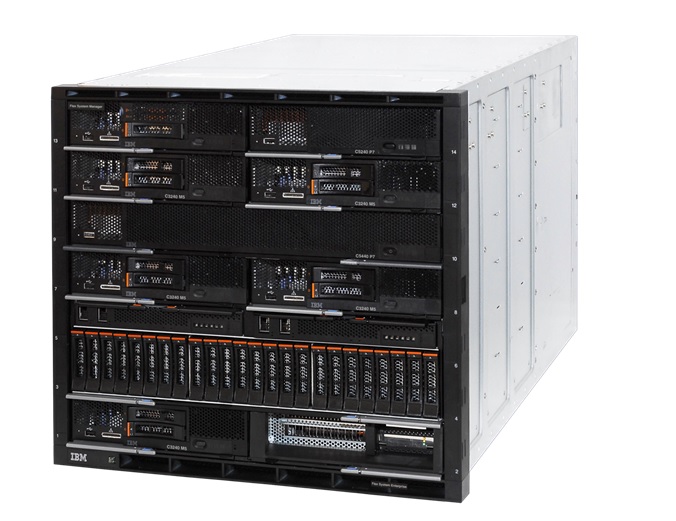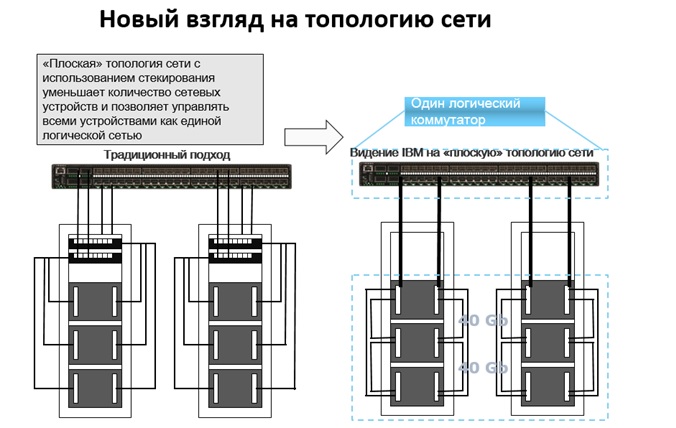IBM Pure Flex System Overview
Colleagues, good afternoon!
At the current resource, and in general, in RuNet there is very little information about the blade systems, about their main differences, advantages and disadvantages.
Mass production of blade systems began in 2002 with various manufacturers and currently has no single standard. The platform of each vendor has as its features. Almost all of them (IBM, Dell, Supermicro, SUN, HP, Intel, Fujitsu) produced but most of the market was taken by IBM and HP, now Cisco is actively catching up (this company started producing such systems relatively long ago) using its “network” authority among customers.
Only IBM can boast that it has retained the platform for the entire time since 2001. That is, Blade Center, designed in 2001, has the same form factor of blade servers and switches as it is now. Only power supply units are different. It is clear that at the moment the platform can no longer boast of any technological advantages with respect to competitors - but to be no worse than them for a 12-year platform is at least not bad.
But today, I want to talk about the platform, which is currently the technological leader in the market for blade systems and is an integrated platform, since its capabilities and functionality are much wider.
It's about IBM Pure Systems
')

What is its main difference from traditional blade systems:
• Consolidation and deep integration of all necessary components (storage, various hypervisors, servers)
• Unified console to manage all elements of the system
• Availability of a set of templates for automated software deployment
In addition, the system has a fundamentally new technological design, which gives the platform new opportunities.
Network infrastructure
A wide and flexible choice of switches, presented are Ethernet - 1 Gbps switches, 10 Gbps switches (both L2 level and L3), 40 Gbps switches, converged 10 Gb switches, Infiniband 56Gbps and 16 Gbps FC SAN from Brocade.

The main difference is that the network infrastructure forms a flat network and is one large logical switch. For combining 10 Gbps of switches, 40 Gbps of uplink are used (1 Gbps of switches - 10 Gbps of uplink), thus creating a high-performance network that is highly demanded when creating large-scale infrastructure solutions that are not limited to one chassis. Also, when creating a virtual infrastructure - virtual machines can quickly migrate throughout the available pool of computing resources and provide a wide channel for backup. Separately, I would like to note the completely non-blocking architecture of switches with high bandwidth, low latency (and again rivals great hello !!!) and a large number of switch ports (up to 64 ports of 10 Gbps each).
Servers
The platform allows you to simultaneously use two types of x86 processors - ie, Intel and alternative RISC servers based on your own IBM Power P7 + processors.
X86 servers
The range of models, ranging from the base with two Intel E5-2400 processors, and powerful with 4-processors.
There are also high density nodes allowing to install up to 28 servers in 10U.
Competitive platforms have limitations on the type of processor to be installed and the number of memory strips (i.e., experiencing difficulties with organizing cooling inside the chassis) even for 16 blades in the same 10U
Those. IBM servers that are used in the solution support processors with a TDP of 135W and also have up to 24 RAM slots onboard (competitors have 2-processor servers with so many memory slots in their portfolio, however, remember that when using processors over 115W, all slots can not be used). This allows you to place on the site much more virtual servers than on similar solutions from competitors. In addition, servers in IBM x240 can install up to 8 SSD, which allows you to get a very fast local disk system within a single server. No other manufacturer can provide such flexibility and scalability within a single node.
And what will happen when new 10-12 nuclear Intel Xeon will enter the market?
IBM Power P7 + Servers
These servers are not compatible with the x86 platform. use a different architecture - RISC. But this architecture is more productive and uses higher frequencies. Linux and AIX operating systems are supported (a reworked IBM version on UNIX). Oracle database users will benefit the most - the high performance of 2 socket systems allows you to stay under the Standard license, saving hundreds of thousands of dollars compared to the Enterprise and Superdome owners. similar ones will also appreciate the ease of migration to this platform with the possibility of increasing productivity.
These servers can be either two sockets with 8 or 12 cores per socket, or 4 sockets.
Built-in storage system.
IBM Storwize V7000 system is used in a special version allowing installation in the chassis.
The main advantages of the system:
• Virtualization of external arrays from other manufacturers, greatly simplifies the migration and allows you to combine all the arrays into one.
• Scalability up to 4 controller shelves in a cluster, and the total number of disks - up to 960 pcs.
• Supports SSD, auto-tier data storage, 1.2 TB disks in 2.5 inches and 4 TB in 3.5 inches, I think no one is surprised ....
Control module .
This module manages the entire system:
• Monitoring and detection of hardware problems (chassis, server and storage)
• Hardware Management
• Network management (both built-in switches and external)
• Disk space management
• Virtualized Resource Management
The main advantage of IBM Flex System Manager is the creation of a unified center of management, monitoring and administration of both physical and virtual resources, both internal and external (through import mechanisms).
Summarizing all the above, this system offers significantly more than the existing similar systems on the market and is the most interesting system in technical terms.
At the current resource, and in general, in RuNet there is very little information about the blade systems, about their main differences, advantages and disadvantages.
Mass production of blade systems began in 2002 with various manufacturers and currently has no single standard. The platform of each vendor has as its features. Almost all of them (IBM, Dell, Supermicro, SUN, HP, Intel, Fujitsu) produced but most of the market was taken by IBM and HP, now Cisco is actively catching up (this company started producing such systems relatively long ago) using its “network” authority among customers.
Only IBM can boast that it has retained the platform for the entire time since 2001. That is, Blade Center, designed in 2001, has the same form factor of blade servers and switches as it is now. Only power supply units are different. It is clear that at the moment the platform can no longer boast of any technological advantages with respect to competitors - but to be no worse than them for a 12-year platform is at least not bad.
But today, I want to talk about the platform, which is currently the technological leader in the market for blade systems and is an integrated platform, since its capabilities and functionality are much wider.
It's about IBM Pure Systems
')

What is its main difference from traditional blade systems:
• Consolidation and deep integration of all necessary components (storage, various hypervisors, servers)
• Unified console to manage all elements of the system
• Availability of a set of templates for automated software deployment
In addition, the system has a fundamentally new technological design, which gives the platform new opportunities.
Network infrastructure
A wide and flexible choice of switches, presented are Ethernet - 1 Gbps switches, 10 Gbps switches (both L2 level and L3), 40 Gbps switches, converged 10 Gb switches, Infiniband 56Gbps and 16 Gbps FC SAN from Brocade.

The main difference is that the network infrastructure forms a flat network and is one large logical switch. For combining 10 Gbps of switches, 40 Gbps of uplink are used (1 Gbps of switches - 10 Gbps of uplink), thus creating a high-performance network that is highly demanded when creating large-scale infrastructure solutions that are not limited to one chassis. Also, when creating a virtual infrastructure - virtual machines can quickly migrate throughout the available pool of computing resources and provide a wide channel for backup. Separately, I would like to note the completely non-blocking architecture of switches with high bandwidth, low latency (and again rivals great hello !!!) and a large number of switch ports (up to 64 ports of 10 Gbps each).
Servers
The platform allows you to simultaneously use two types of x86 processors - ie, Intel and alternative RISC servers based on your own IBM Power P7 + processors.
X86 servers
The range of models, ranging from the base with two Intel E5-2400 processors, and powerful with 4-processors.
There are also high density nodes allowing to install up to 28 servers in 10U.
Competitive platforms have limitations on the type of processor to be installed and the number of memory strips (i.e., experiencing difficulties with organizing cooling inside the chassis) even for 16 blades in the same 10U
Those. IBM servers that are used in the solution support processors with a TDP of 135W and also have up to 24 RAM slots onboard (competitors have 2-processor servers with so many memory slots in their portfolio, however, remember that when using processors over 115W, all slots can not be used). This allows you to place on the site much more virtual servers than on similar solutions from competitors. In addition, servers in IBM x240 can install up to 8 SSD, which allows you to get a very fast local disk system within a single server. No other manufacturer can provide such flexibility and scalability within a single node.
And what will happen when new 10-12 nuclear Intel Xeon will enter the market?
IBM Power P7 + Servers
These servers are not compatible with the x86 platform. use a different architecture - RISC. But this architecture is more productive and uses higher frequencies. Linux and AIX operating systems are supported (a reworked IBM version on UNIX). Oracle database users will benefit the most - the high performance of 2 socket systems allows you to stay under the Standard license, saving hundreds of thousands of dollars compared to the Enterprise and Superdome owners. similar ones will also appreciate the ease of migration to this platform with the possibility of increasing productivity.
These servers can be either two sockets with 8 or 12 cores per socket, or 4 sockets.
Built-in storage system.
IBM Storwize V7000 system is used in a special version allowing installation in the chassis.
The main advantages of the system:
• Virtualization of external arrays from other manufacturers, greatly simplifies the migration and allows you to combine all the arrays into one.
• Scalability up to 4 controller shelves in a cluster, and the total number of disks - up to 960 pcs.
• Supports SSD, auto-tier data storage, 1.2 TB disks in 2.5 inches and 4 TB in 3.5 inches, I think no one is surprised ....
Control module .
This module manages the entire system:
• Monitoring and detection of hardware problems (chassis, server and storage)
• Hardware Management
• Network management (both built-in switches and external)
• Disk space management
• Virtualized Resource Management
The main advantage of IBM Flex System Manager is the creation of a unified center of management, monitoring and administration of both physical and virtual resources, both internal and external (through import mechanisms).
Summarizing all the above, this system offers significantly more than the existing similar systems on the market and is the most interesting system in technical terms.
Source: https://habr.com/ru/post/193512/
All Articles